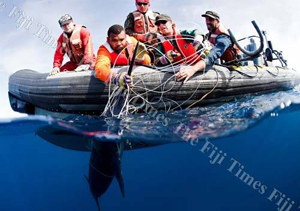
Avinesh Gopal
SUVA (The Fiji Times / Pacific Media Watch): Two Fijian activists from Greenpeace protested against a Taiwanese tuna longliner yesterday and later helped free a marlin from the ship's longline hooks.
Greenpeace said the two activists on the Esperanza protested against the vessel San Sheng Shiang No 868, which was fishing in the Pacific high seas.
The activists demanded that Taiwan support strict conservation measures to protect the remaining valuable tuna stocks in the Western and Central Pacific.
Greenpeace Australia Pacific Oceans campaigner Duncan Williams and activist Apisalome Waqanisau are on board the environmental organisation's largest ship, Esperanza, which is on a Defending our Pacific expedition.
The expedition is part of a campaign to prevent the plunder of Pacific tuna and to restore the health of the world's oceans.
Recently, it was reported that more foreign fishing vessels cross into the Fiji maritime zone and fish at will without being caught.
Greenpeace media adviser Josephine Prasad said the activists asked the Taiwanese vessel to stop fishing in international waters that flank several Pacific island countries exclusive economic zones in support of the countries to close these areas to all fishing.
"Just last week, Nauru proposed the closure of the Pacific Commons to longline fishing at the Technical and Compliance meeting of the Western and Central Pacific Fisheries Commission," Prasad said.
"This closure would add to the current bans on purse seine fishing in these areas long known to be hot spots for illegal, unreported and unregulated fishing."
Prasad said with tuna stocks in other oceans now depleted, fishing fleets from Asia, United States of America and Europe have turned their attention to the Pacific, which is the source of more than half of all tuna consumed globally.
"Longliners mainly target big eye, yellowfin and albacore tuna destined for luxury sashimi markets in major cities across the world."
"Big eye and yellowfin tuna were recently assessed under the International Union for the Conservation of Nature criteria for threatened species and are classified as vulnerable and near threatened. In addition, about 35 percent of longline catch consists of non-target species, including threatened oceanic sharks and turtles."
Prasad said many longline tuna vessels also engaged in controversial shark finning activities and have been documented in numerous illegal fishing activities.
"It is estimated that between 21 and 46 percent of the tuna caught in the Pacific is taken by pirate fishing ships, mostly longliners."
(cc) Creative Commons



